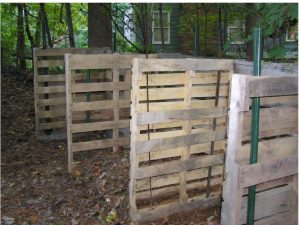Composting is an excellent way to recycle organic waste and enrich your garden soil. A three-bin compost system allows for efficient decomposition by providing designated spaces for different stages of the composting process. This guide will show you how to construct a simp le, cost-effective three-bin system using wooden pallets.
le, cost-effective three-bin system using wooden pallets.
Materials Needed
- 7 wooden pallets (similar in size)
- 14 rebars or landscaping stakes (5–6 feet long)
- Hammer
- 18 wire coat hangers (untwisted)
- Sticks (to cover the ground at the bottom of bins)
- Green and brown compostable materials
- Garden soil or finished compost (to jump-start decomposition)
- Water
- Chicken wire (optional, for added stability)
Step-by-Step Construction
Step 1: Arrange the Pallets
Many businesses will give away their used pallets. Try big box stores or any business that unloads merchandise or supplies on pallets.
- Lay out three pallets to form the back of the bins and use four for the sides.
- Turn the pallets on their sides so that the rebars can be inserted through the middle slats for stability.
Step 2: Secure the Pallets
- While one person holds the pallet upright, the other hammers two rebars or stakes between the wooden slats to temporarily hold it in place.
- Repeat this process for the remaining pallets until you have three adjoining bins.
Step 3: Reinforce with Wire
- Twist wire from untwisted coat hangers around the top, middle, and bottom corners where the pallets connect to reinforce the structure.
Step 4: Prepare the Bin Floor
- Cover the bottom of each bin with sticks. This helps aerate the compost pile and prevents tree roots from growing into the compost.
Step 5: Start Composting
Now that your bins are ready, you can begin the composting process. There are two common ways to use a three-bin system:
- Layering & Turning Method:
- Begin adding alternating layers of brown materials (e.g., shredded leaves) and green materials (e.g., grass clippings, vegetable scraps) in the first bin.
- When the compost needs turning, move it into the second bin.
- Transfer the compost from the second bin into the third bin for the final stage of decomposition.
- Storage & Active Composting Method:
- Use the middle bin as your primary composting area.
- Use one of the side bins to store shredded leaves or other brown materials for future use. This is particularly helpful during warmer months when green waste is more abundant.
Final Tips for Effective Composting
- Maintain a balance of green (nitrogen-rich) and brown (carbon-rich) materials.
- Keep the compost moist, like a damp sponge—add water if it dries out.
- Turn the pile regularly to aerate it and speed up decomposition.
- Avoid adding meat, dairy, oily foods, or pet waste, as they can attract pests.
A three-bin system is a great solution for gardeners looking to manage compost efficiently. By following this guide, you can create a sustainable composting setup using recycled materials while enriching your soil naturally.

